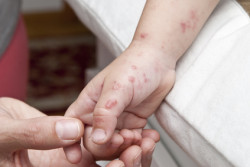Top Class Actions’s website and social media posts use affiliate links. If you make a purchase using such links, we may receive a commission, but it will not result in any additional charges to you. Please review our Affiliate Link Disclosure for more information.

Yet, in some rare cases, the medication that is supposed to improve their daily lives, may actually induce a serious and potential fatal skin reaction known as Stevens Johnson Syndrome (SJS) or Toxic Epidermal Necrolysis (TEN).
About Stevens Johnson Syndrome
Stevens Johnson Syndrome, commonly referred to as SJS, is a rare skin condition that is almost always caused by a strong and severe allergic reaction to certain over-the-counter and prescription drugs, including Dilantin. SJS is a painful disease, which can cause graphic skin loss of between 10 and 30 percent of total skin mass.
Dilantin skin side effects that may be Stevens Johnson Syndrome could start with a fever, sore throat and fatigue. Ulcers and other lesions begin to appear in the skin, often in the mouth and lips or in the genital regions. A rash or lesions typically develop on the face, trunk, arms, legs and soles of the feet. These skin blisters after Dilantin use are extremely painful and debilitating.
In more severe cases, the skin reaction is known as Toxic Epidermal Necrolysis or TEN, an even worse form of SJS where more than 30 percent of the body’s skin mass is affected and as many as 35 percent of patients afflicted, die.
These catastrophic allergic reactions to Dilantin are life-threatening and can also result in blindness, organ dysfunction and death. Dilantin SJS symptoms include rashes, redness, blisters and eventually can entail the shedding of major parts of the victim’s body surfaces. Stevens Johnson Syndrome from Dilantin often results in hospitalization with treatment in an Intensive Care Unit (ICU) or Burn Unit.
Dilantin SJS Symptoms
Potential symptoms of Stevens Johnson Syndrome or Toxic Epidermal Necrolysis from Dilantin could include:
- Rash, blisters or red spots on the skin
- Blisters in the mouth, eyes, ears, nose or genital area
- Swelling of the eyelids
- Fever or flu-like symptoms
Although many medications can cause SJS or TEN, side effects of Dilantin appear to increase the risk, especially among some users of the medication.
FDA Dilantin Skin Side Effects Warning
Dilantin (phenytoin) was first approved by the FDA in 1953 for treatment of seizures. The medication is also sold under the name Phenytek or Phenytoin.
The FDA required new warnings about potential Dilantin SJS side effects to be added to the drug’s label in November 2008. Data suggests that individuals of Asian ancestry who carry the gene allele HLA-B*1602 may face a substantially increased risk of the Dilantin skin problems.
Although it appears that information has been available for some time that Dilantin increases the risk of Stevens Johnson Syndrome and Toxic Epidermal Necrolysis, Dilantin lawsuit allegations indicate that the drug makers placed their desire for profits before safety of consumers by failing to adequately warn about the potential skin reactions.
If you or a loved one used Dilantin to control a seizure disorder and later developed Stevens Johnson Syndrome or Toxic Epidermal Necrolysis, you may be entitled to compensation through a Dilantin SJS lawsuit as a result of inadequate warnings provided by the drug makers.
Do YOU have a legal claim? Fill out the form on this page now for a free, immediate, and confidential case evaluation. The Stevens Johnson Syndrome attorneys who work with Top Class Actions will contact you if you qualify to let you know if an individual lawsuit or class action lawsuit is best for you. [In general, SJS lawsuits are filed individually by each plaintiff and are not class actions.] Hurry — statutes of limitations may apply.
ATTORNEY ADVERTISING
Top Class Actions is a Proud Member of the American Bar Association
LEGAL INFORMATION IS NOT LEGAL ADVICE
Top Class Actions Legal Statement
©2008 – 2024 Top Class Actions® LLC
Various Trademarks held by their respective owners
This website is not intended for viewing or usage by European Union citizens.
Get Help – It’s Free
Help for Victims of Stevens Johnson Syndrome
If you or a loved one were diagnosed with Stevens Johnson Syndrome (SJS) or toxic epidermal necrolysis (TEN) after taking a prescribed or over-the-counter medication, you may be eligible to take legal action against the drug’s manufacturer. Filing an SJS lawsuit or class action lawsuit may help you obtain compensation for medical bills, pain and suffering, and other damages. Obtain a free and confidential review of your case by filling out the form below.
An attorney will contact you if you qualify to discuss the details of your potential case at no charge to you.
Oops! We could not locate your form.












